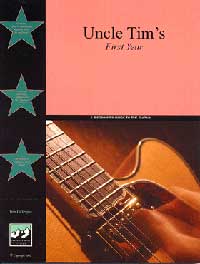

If You Are Going To Play In A Key Every Day, Shouldn't You Learn That Way?
Yes, you should!
Music is key based. You are always in one key or another. Always!
Yet playing a guitar is not taught that way! Why?
Once you understand keys and the chords and scales that come from keys, the whole world of music opens up before your eyes!
Suddenly everything is MUCH easier. And it totally makes sense when you get into it.
For $15, you can put this all to rest right now. Pick up a copy today.
eBooks are delivered instantly!
by Tim Gillespie
Example number 1.
This is a simple passage with two different components.
The idea is to become familiar with changing up the sequence of notes to create interest. These two runs provide an opportunity to experiment with different combinations.
This is meant as an introductory run. It is unassuming and should fit into the background.
I would try different combinations based on this. Use this as an opportunity to experiment.
Hit your browser refresh button to start this again.
Example number 2.
These get more complex as you go.
 These runs
are useful when played against these chords. You will see the runs are
working in the same area as the chords.
These runs
are useful when played against these chords. You will see the runs are
working in the same area as the chords.
This provides an opportunity to play off the notes in the chords.
These runs work in a descending manner until they arrive at the G note. Keep in mind that this arrangement may favor the relative minor keynote of E, so you can experiment with changing the ending to use a E note.
Hit your browser refresh button to start this again.
Example number 3.
 This example is interesting in that it plays off the open string E note.
This can be a useful trick when trying to reach the higher registers.
You can easily climb and still maintain a connection with the E note.
This example is interesting in that it plays off the open string E note.
This can be a useful trick when trying to reach the higher registers.
You can easily climb and still maintain a connection with the E note.
Try playing these runs over these chords. You may be able to alter this run a little to come up with alternatives.
Hit your browser refresh button to start this again.
Example number 4.
This pathway is quite versatile. You can use it for many different styles of music and it works very well for rock. If you have developed skill at playing the closed position scale, you may find this to be full of creative statements.
I would definitely suggest playing with this pathway because there are many different entry and exit points and chord combinations you can explore.
Hit your browser refresh button to start this again.
Remember this! It's not that these runs are any different or harder than others you may hear. It's just that if you play them 100 times each, you will start to get to know them. Practice is what makes you better.